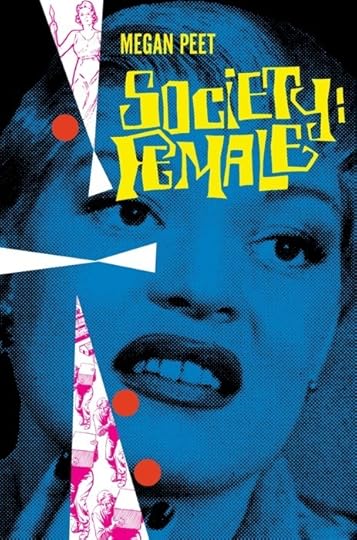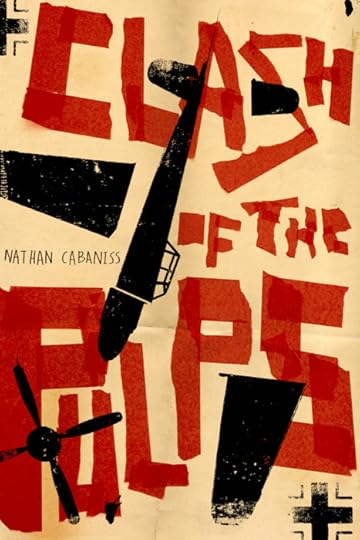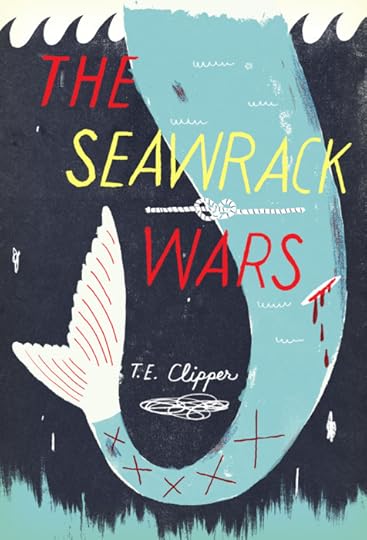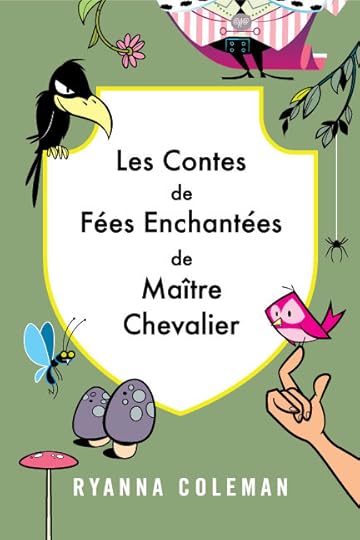Chris Baty's Blog, page 250
November 14, 2011
30 Covers, 30 Days 2011: Day 14
Happy Monday! I hope you had incredibly productive weekends—Paige, our intern of the highest caliber, had an 11K day! Today's cover, set to inspire and amaze, comes from Jesse Marinoff Reyes:

Society: Female by Megatron14
After the third world war (also known as WWW, the Women's World War), society is run by females. All surviving men are imprisoned in different facilities, or work as slaves in factories. The most troublesome men are sent to a place called The Institute, where unspeakable things are done to them, after which the men are never seen again.
But Cassandra Grayson has secretly been in contact with her father for years, and she's not happy with the ways things seem for him. When all messages from her father cease suddenly and she comes across a boy who proposes an interesting proposition, Cassandra must make a hard choice; perhaps one that could mean life or death for many people, including herself. Can she overcome a world where the best and worst sides of women, the sweet and the ruthless reign, or will she settle into complacency?
Jesse Marinoff Reyes is a freelance designer. The former art director of The Rocket (Seattle), Guitar World magazine and The Village Voice, he was an associate art director in the Penguin Books adult trade division for 12 years. He is the author of Next: The New Generation in Graphic Design (North Light, 2000). He lives in the hamlet of Maplewood, NJ, with his wife Amy and little daughter, Melina.
Mondays are now 30C30D's Young Writers Program days! Megan is our very first Young Writer, and has set a word count goal of 30,000. Give both her and Jesse a boost below!
November 13, 2011
30 Covers, 30 Days: Day 13
It's lucky day thirteen! No better day to pepper your writing with hoaxes, pranks, and misfortune. Today's cover is brought to you by the very talented Edel Rodriguez:

Clash of the Pulps by nbcabaniss
1947. The war is over, and the heroes are gone. Once shining and glorious and everything humanity aspired to be, the heroes of the 1930's are now either retired, missing or dead; their golden age brought to a screeching halt with the advent of the Second World War. Now, three of the world's greatest adventurers must return:
There's Alexander Steele, III, one of the smartest men in the world and an Olympic-level athlete, someone on whom the war has taken its toll. He spends his nights now alone - waiting, hoping for a chance to restart his glory days.
Albrecht Engel, a German-born fighter pilot - some say the best in the world. He carries the burden of the destruction of the Phantom Legion, his own private army of pilots and airmen, for which he feels responsible.
And Dusk, the masked vigilante who haunted Depression-era Manhattan, cleansing the mean streets of the dregs of society. But is he really who he claims to be? Just who exactly is it under that mask?
Now, all three must put aside their personal demons and return to stop one of their oldest, most powerful foes…
Edel Rodriguez was born in Havana, Cuba in 1971. He graduated from Pratt Institute in 1994 and began working regularly as an illustrator for the New Yorker, TIME magazine, and a variety of other clients. His work is regularly selected to appear in the American Illustration, Communication Arts and The Society of Illustrator's annuals. Edel's artwork has appeared on numerous book covers, Broadway show posters, U.S. postage stamps, product designs and ad campaigns. He has illustrated six children's books, two of which he has authored.
November 12, 2011
30 Covers, 30 Days: Day 12
I don't know about you, but I'm hoping for a Saturday, free and clear, and ready to be filled up with at least 5000 words! Get your typing fingers at the ready, but first, take a gander at today's cover, designed by the fantastic Chris Silas Neal:

The Seawrack Wars by tomato-greens
The first time Zee Khalil saw a mermaid scalp for sale, she was ten. Six years later, the mermaid tourist trade is the only thing standing between her small island fishing town and its absorption into one of its larger mainland neighbors. Though the town has received some negative press, Zee's never seen a problem––mermaids are legal prey, and traps have come a long way since the first mermaids were netted. She should know; after all, her dad was one of the first fishermen to adopt and promote the new humane policies.
Then his body washes up on shore, wrapped carefully in mermaid hair. All of a sudden, the town is flooded with big city reporters and the governor's being pressured to shut them down. Someone's not following the rules. And Zee plans on finding out who.
Chris Silas Neal is an illustrator and designer whose work has been published by a variety of magazines and publishers and, featured on television. His book jackets and posters have been recognized by the AIGA, Type Directors Club and American Illustration. His first picture book titled, "Over and Under the Snow" with author Kate Messner has just been released by Chronicle Books. He keeps a studio in an old Pencil Factory located in the Greenpoint section of Brooklyn.
Keep an eye out next week for a blog post from John Gall, art director at Vintage / Anchor Books and helmer of 30C30D, checking in on our project as we approach the halfway point. And please let Chris and T.E. know what you think!
November 11, 2011
30 Covers, 30 Days 2011: Day 11
Happy Friday! And for those of you who celebrate it—Happy Veteran's Day! Thank you so much for making 30 Covers, 30 Days such a success as we end this second week of November. Today's cover was created by Chip Wass, designer extraordinaire:

Les Contes de Fées Enchantées de Maître Chevalier by Ryanna Coleman
From Cinderella to Thumbelina, with Snow White, Peter Pan and King Arthur in between, as well as many many other famous and popular fairy tales, this collection of retold fairy tales is darker than most.
And with five new fairy tales that will delight the reader and a foreword and conclusion by chronicler Master Chevalier, Les Contes de Fées Enchantées de Maître Chevalier will be a timeless classic.
Chip Wass has created characters, illustrations and logos for Disney, Nick at Nite, Cartoon Network, Target, The New York Times, Entertainment Weekly among others. He is currently writing and illustrating a novel for young readers. Visit www.chipwass.com.
Thank you again for all of your insight and discussion of these covers this week! In case you're curious, we've posted the letter that goes out to our writers upon selection in our forums here. Have a wonderful, novel-full weekend!
E-Publishing My NaNo-Novel

When we heard that author Gayle Brandeis had self-published one of her NaNoWriMo novels as an e-book, we reached out to get her take on the differences between self-publishing and traditional publishing. She graciously agreed to write a guest blog post about her experiences. Take it away, Gayle!
When I wrote The Book of Live Wires during NaNoWriMo 2002, I never thought anyone would read it.
The novel is a sequel to The Book of Dead Birds, which had won Barbara Kingsolver's Bellwether Prize for Fiction in Support of a Literature of Social Change earlier that year—the most exciting thing that had ever happened to me as a writer, but also the most discombobulating. I came down with writer's block for the first time in my life; I let myself believe that every word I wrote from then on had to be worthy of a national award. NaNoWriMo helped me get back out of my own way; it returned my writing to me in all its messy, juicy glory.
Over the years, I've mentioned the sequel at my readings and book club visits. Readers have always expressed interest, but I've told them I didn't have any plans to release the novel—it was too raw, too much of a personal project. It didn't feel right to share it, somehow. But enough people asked that I finally decided to take another look, and was surprised by how much life I found inside the story. I shared the draft with my first reader and dear friend Laraine Herring, who thought the book contained some of the best writing of my life (which was both awesome and awful to hear—had I really not written anything as good in almost a decade?!).
After some revision, I started to think about how to go about releasing the novel. The publishing world has changed a lot since 2002. I have published five books with major presses (including another NaNoWriMo novel, Self Storage) in the intervening years, and have watched budgets for promotion of said books plummet. Publishers have gone from arranging multiple city book tours with fancy hotels for midlist authors like myself to setting up a couple of local readings within driving distance of home. Much of the promotion has gone online—blog book tours, book trailers on YouTube, Skype visits with book clubs. It's a whole new world, one authors need to learn to navigate and be proactive about if we hope to stay relevant.
When I first started hearing about the shift to digital books, I was horrified, but eventually I let myself realize how exciting it is to live during a time of transition, of change. I decided to embrace that shift rather than resist it—to see it as an opportunity, an adventure, rather than a death knell. And I realized that it behooves writers, who are increasingly in charge of our own promotion, anyway, to learn how to take publishing into our own hands. So I decided to do just that.
Nine years after I sat down to write it, The Book of Live Wires is now available as an e-book. I released the novel in November to celebrate NaNoWriMo and to get a head start on celebrating the 10th anniversary of the Bellwether Prize this coming January. Self-publishing has required a steep learning curve, but it's been a fun and illuminating journey.
Being in control of every aspect of the process—from finding and negotiating the use of a cover image on flickr to choosing which platform to use (I decided on a combination of Smashwords and Kindle) to obtaining ISBN numbers and taking out all the tab indents, page breaks, etc. in order to format the manuscript properly—is exhilarating and at times overwhelming. And of course now all the promotion is in my hands, too. (Although I've enlisted a professional publicist to help with this, something I've done on occasion when I've published books traditionally, as well, to get more muscle behind the book and reach further than I could on my own.)
I see all this as a grand experiment. I do hope to continue to publish books the old-fashioned way—I am grateful for the support and storied tradition of the established publishing world (plus I want to help keep brick-and-mortar bookstores alive!)—but I'm happy to know that I can always choose to release my work on my own, if I so desire. We have the power—the power of the pen, the power of the pixel. Let's use that power to create a brave and beautiful new world of words.
November 10, 2011
30 Covers, 30 Days 2011: Day 10
It's already been 10 full days of writing wonder, and 10 full days of designer goodness. How are you all holding up? Today's cover is from the prolific and paramount Tal Goretsky:

A Maddening Science by Vega
Bullets fired into a crowd. Screaming. Blood. Police sirens in the distance, coming closer, making me cringe against old memories. Making me skulk into the shadows, hunch down in my hoodie. The last place I want to be is the centre of attention for the cops again. I sink back into the fabric, shying from the broad helicopter searchlights. But there are people bleeding into the gutter. Children screaming. Women crying. Men crying, too, not that any of them would admit it. The scent of gun powder, rotting garbage, vomit, and misery.
If this had been before, I might have leapt into action with one of my trusty gizmos. Or, failing that, at least with a witty verbal assault that would have left the moron too brain-befuddled to resist when I punched him in the esophagus.
But this isn't before. This is after, and I am a supervillain no more.
… Let me tell you about before.
Tal Goretsky is a senior designer at The Penguin Press
J.M. Frey is writing from the great nation of Canada! We love our international Wrimos, even if they're a hop, skip, and a jump away. Let J.M. and Tal know what you think!
Conversations with Your Novel

I've got a bad case of the Week Two Blahs.
My novel taunts me from another window. "Hey Sarah!" I hear it saying. "I kind of suck! I'm getting a little rambly and nothing much of anything has happened in about three chapters!"
I try to ignore it, knowing that it's wrong—I just introduced my love interest and had a dramatic injury! Things are happening!—but it's hard, in Week Two, not to listen to your novel. "Your main character just collapsed in front of her future love interest's house and you couldn't even make that interesting! You're terrible at this! Maybe you should go knit something and play with your cat, because obviously there's no point in you ever writing anything again!"
I protest, but my position is weakening. "Maybe the whole injury scene wasn't my best writing, but at least things are happening. This time last year my main character had just gone to the bank, for god's sake. This is real progress!"
But my novel's got an answer for that one, too. "Just because last year's novel was even worse than I am doesn't mean I'm any good. Slightly less poisonous mushrooms are still poisonous."
"Sure," I retort, "but you can't deny that we've got some exciting things coming up here pretty quick if I can just sit myself down and get to them. Her boyfriend is about to dump her for getting injured! That's bound to be fun to write. Everyone likes writing about jerky boyfriends."
"Oh, yeah, that's really original," my novel sneers. "Dust off your mantelpiece for all the awards you'll be winning any minute with this remarkable prose."
"Listen, Novel," I say, and I'm starting to get a little huffy. "You've got a pretty big nerve for a novel that's barely over 11,000 words and doesn't even have a title yet."
"What's the point in giving me a title? Nobody's ever going to read me anyway." Great. Now my novel's getting all emo.
"Sorry, Novel. I know you think you're clever, reminding me about all the things that totally suck about you. But I know better. I know that if I can just keep fighting through Week Two, I'm going to get to Week Three. And Week Three is where the magic happens. So I'm just going to keep getting the words on the page, no matter how tedious they are, and then one day, I'm going to notice that things are suddenly happening again, that your characters have started to speak for themselves again, that your dialogue is snappy again. Or at least, that's what I'm going to tell myself so I survive Week Two."
"I like your moxie, kid. I think you're going places."
"Thanks, Novel. Now shut up and get back to writing yourself."
"That's not now this works, you know. You might have successfully anthropomorphized me for a blog post (that we all know was just an excuse to procrastinate working on me), but you still have to write me."
"Well, it was worth a try."
What's your novel saying to you these days?
– Sarah
Photo by Flickr user ntr23
November 9, 2011
30 Covers, 30 Days 2011: Day 9
Shoot, these covers are kind of a master class in how to turn an incredibly creative work around in 24 hours, aren't they? I know it's inspiring me to get busy on my novel with only 21 more days ahead, though I am glad I won't have to share my first draft with everyone at the end of the month. Today's cover was designed by the one, the only Paul Sahre:

Oh God, the Aftermath by detailsofthewar (Allie O'Bannon)
Medical science had made so many leaps and bounds that people were living well into their hundreds. Four or five generations all using the same resources and living on the same land was putting a major strain on the economy. There wasn't enough money to go around, enough jobs or enough food and definitely not enough space. The economy weakened and then collapsed entirely. No one but a very small percentage of the world's population was spared from plunging into abject poverty.
This is the world Tosh Brandt is born into, a world without hope. The government is having trouble keeping up with the demand of the engorged population and the food supply is dwindling with very little possibility to grow more in the polluted, over crowded environment.
Out of desperation, the government develops a secret campaign to thin the herd. They begin by limiting food supplies to certain areas of the country, except that those in rural areas begin to flock to the cities and the promise of all they can eat. When that doesn't work, the government's militia strike in the dead of the night, taking whole families. Despite their best efforts, disappearances are widely talked about. But very few people understand what's going on. Those who do decide to fight back.
Paul Sahre is a graphic designer working out of his own office in New York City. He just finished building a life-size paper monster truck hearse.
Let Paul and Allie know what you think!
Guerilla Writing Tactics

Hey, Wrimos! Yesterday evening, after getting to 12,000 words, I treated myself to a delicious bowl of phở. For those unfamiliar, it's a Vietnamese beef noodle soup that I've been craving ever since it started getting chilly (note: "chilly" where I live means plus or minus 50°F). It's part of a rewards system I developed. I figured that if I pit myself against myself for the sole purpose of making my word count, I couldn't go wrong. The only thing is that I really have to hold myself accountable.
I have come to terms with the fact that I'm a pantser. Up until two days before November 1st, I couldn't decide what to write about. It was really the deadline-induced panic that forced me to commit to a single idea. And even though I use occasional rewards to encourage myself, that same anxiety about falling behind is the single greatest incentive for me to keep going.
I've participated in NaNoWriMo two other times, but this is really the first time I'm keeping up, and so it's the first time that I feel like I could win. I have never been known as a prolific writer. Before NaNoWriMo my longest story was 25 double-spaced pages and even that was a big deal. Now that I have gotten to 25 single-spaced pages, I will share some of the things I have learned. I call them guerilla writing tactics. They are for the days where nothing seems to be going on in your story, and you want to make your word-count goal, but can't come up with any ideas. You may already be familiar with them, and if so, wonderful! As I said before, I'm not an experienced Wrimo, and these are just things that I found have worked for me.
You want to write an exciting scene, but you have to write a boring scene to get to the exciting scene? No you don't! Write the exciting part now. Get to the in-between stuff later! Once I wrote a scene wherein someone ate a strawberry. Wanting to bypass the description, I made a note to myself in the margin saying, "Describe a freakin' amazing strawberry!" and circled it a bunch of times. Then I kept going.
Need 200 words? Write a song and put it in your novel. Or find a song that already exists and stick it in. It's probably best if it's pertinent to the story, but hey, it ain't wrong if Tolkein did it! (And he did it a lot.)
Need 400 words? Have characters write to each other. Or take a bad dream you had recently and give your character nightmares when he or she is feeling particularly distressed.
Need 800 words? Mess around with the weather. It forces characters to interact with one another, sometimes frustratedly, due to the fact that the weather has ruined their plans. And every time you can't think of a bit of dialogue, you have the option to break things up with thunder and power outages where you force your characters to find candles and trip over things.
Finally, it doesn't hurt to you have your profile open, so every time you find yourself pausing, you can check your word count and update it accordingly. Even if it's only a 50-word increase, the satisfaction is immense.
Do you novelists (experienced or otherwise) have tips for those slow days?
– Ari
November 8, 2011
30 Covers, 30 Days 2011: Day 8
Good morning! If you're enjoying 30 Covers, 30 Days, you might also dig our NaNo Artisans forum—loads of awesome art created by and for other Wrimos! Today's cover was designed by the superlative Mark Abrams:

Marigold Man by Argyle Schield
A regular joe named Paul, anonymous office worker by day and gardener by other times, discovers the incredible fecundity of marigolds: one plant produces hundreds of seeds, each of which can produce hundreds more.
He hatches (or plants) a plan to change (or at least brighten a bit) the world with marigolds. He starts his little revolution solo, planting seeds wherever he can, but soon discovers his noble but (frankly) pathetic efforts barely make a dent. The world is still the useful, practical, prosaic place it has always been. He finds a group of (somewhat) like-minded people who, next planting season, join the quest.
The small group, by the third year, becomes almost an army (a word Paul hates because it's the antithesis of everything marigold), a veritable congregation of marigold planters, determined optimists who only want a world with a dab of color and poetry. His revolution grows to sizes and takes him to places he never dreamed he'd get to, so much so that he almost loses himself and everything he values most in the process.
Mark Abrams designs covers for Vintage Books and lives in Brooklyn, with his wife and baby. His first full-length work was "A History of the Jewish People," written at age six.
Let Mark and Gary know what you think! Best of luck with all your writing this week—we're wishing you a veritable thunderstorm of words.
Chris Baty's Blog
- Chris Baty's profile
- 63 followers



